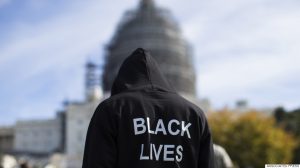
Professor of sociology, University of California at Berkeley
Video cameras have transformed how we view police killings. First, there was the horrifying homicide in July 2014 of Eric Garner, placed in a choke-hold for selling loose cigarettes and denied medical assistance for several long minutes despite pleading “I can’t breathe” eleven times. Then there was the shocking slaying in April 2015 of Walter Scott, stopped for a non-functioning third brake light and shot in the back in broad daylight while running away from the police. Most recently, there was the fatal shooting this July of Samuel Dubose, stopped for a missing front license plate and shot in the head while attempting to drive away. In all three cases — two of them caught by citizen videos and the third by police camera — the victims were African-American.
In the wake of these events and protests that have done so much to focus public attention on them, our knowledge of police killings has rapidly expanded. So, too, has the issue’s political salience. The videos — and the outrage that followed — helped ignite the most powerful civil rights movement since the 1960s. Thanks to this movement, the issues of police killings and mass incarceration are now squarely on the public agenda.

Like the movements against lynching, state-sanctioned segregation and the death penalty before it, today’s movement is part of a centuries-long struggle for racial justice. These movements have repeatedly challenged the taken-for-granted practices of the day and redefined them, step-by-step, as no longer morally acceptable. As I will discuss below, this pattern describes the struggle that led to the decline and ultimate elimination of lynching, and it captures as well the ongoing fight against the death penalty that may well culminate in its abolition. Today’s movements aim at a similar transformation: to define routine police killings and mass incarceration — practices now taken for granted as normal features of American life — as neither normal nor morally acceptable.
How Common Are Police Killings?
The current movement emerged out of mounting anger over the killing of unarmed citizens by police. When the question of how often such killings take place quite naturally arose, the shocking answer was that no one knew — a state of affairs the FBI director James Comey has aptly described as “embarrassing and ridiculous.” Though the FBI annually issues a report that provides figures on “justified police homicides,” reporting from local police forces is voluntary and thousands of them turn in no information. Investigations by the Wall Street Journal and FiveThirtyEight determined that hundreds of police killings went unreported annually, but they could do no more than provide rough estimates. This is in striking contrast to many European countries, where every killing by the police is carefully recorded; indeed, in Germany and Finland, each and every shot fired by the police is entered into a national database.
In response to the upsurge in public interest in police killings, the Washington PostandGuardian have stepped in to perform a task that should have been done by the government: the recording of every police killing. Though the newspapers use slightly different methodologies, both newspapers draw on two citizen-initiated sources, “Killed by Police” and “Fatal Encounters,” which collect news reports of people killed by law enforcement offices, and both include data on whether the person was armed.1 In addition to the time and place of the killings, both databases include basic demographic information, including race, gender, and age. Neither attempts to determine whether the killings should be deemed “justified.”
As recently as the summer of 2014, when the deaths of Michael Brown and Eric Garner thrust the issue of police killings into national prominence, the most widely used estimate of the number of people killed by police was provided by the FBI’s Uniform Crime Report: slightly more than 400 per year. But we now know that this figure was a gross underestimation, for the actual number is more than 1,100 police killings each year — about one every eight hours.2This is a level of police violence that is simply unimaginable in other wealthy democratic country; in Germany in 2012, a total of seven people were killed by the police, and in England a single person was killed in 2013 and 2014 combined. And Japan, a nation of 126 million people that is as non-violent as the US is violent, had no police killings over the past two years.
Read more here :Police Killings Surpass the Worst Years of Lynching, Capital Punishment, and a Movement Responds



















